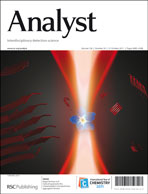Wavelet unfolded partial least squares for near-infrared spectral quantitative analysis of blood and tobacco powder samples
Abstract
Continuous wavelet transform (CWT) has been shown to be a high-performance signal processing technique in multivariate calibration. However, the signal processed by CWT with a specific wavelet may account for only a part of the information. To effectively utilize more abundant information contained in analytical signals, a method, named as wavelet unfolded partial least squares (WUPLS), was proposed. In the approach, the measured dataset is firstly extended by CWT with different wavelets, and then partial least squares (PLS) is employed to develop the quantitative model between the extended dataset and the target values. In order to select the representative wavelets, principal component analysis (


 Please wait while we load your content...
Please wait while we load your content...